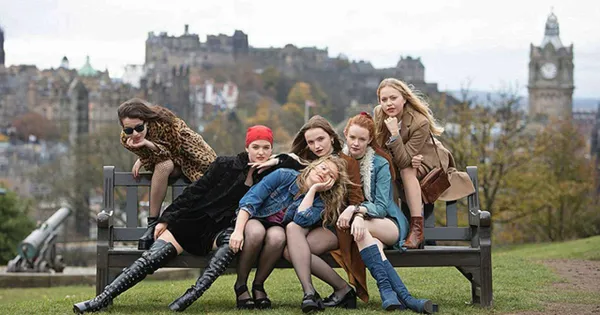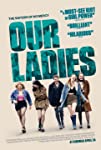Eye For Film >> Movies >> Our Ladies (2019) Film Review
Our Ladies
Reviewed by: Andrew Robertson

The Lady of Perpetual Succour is, of course, the Virgin Mary herself, an icon depicting not only the Madonna but Archangels Gabriel and Michael, instruments of crucifixion, and the infant Jesus who still looks perturbed by the goings on some five centuries and change after the first recording of the work. Though the name of the institution is, one suspects, less about a connection to the Patron Saint of Haiti or any affiliation to the Redemptorists but for the opportunity to add a flavour of blasphemy to jokes about blowjobs.
There's a church in Glasgow named for her, but this film (and the other works) posits a Catholic High School with attendant choir and so forth. It puts it in Fort William, up near Glencoe. One can grant dramatic license for this, it's important it be far from a big city and where they can see submarines. It's perhaps not too obvious that this would have made it the northernmost Catholic State School in Europe, dethroning Lawside (1907/2008) in Dundee. It's perhaps not too obvious that it must be so because the sign says 'West Highland Council' too, though there never was such a beast, it would have been Lochaber District within Highland Regional Council, and in and among the legislative changes to local government (including, importantly, section 28), it would become Highland. It's perhaps not too obvious that it's just three hours from Fort William to Edinburgh by bus, so the odds of a school choir arriving several hours early for an event starting at six and letting them wander off in the middle seem low, even if the desire is to avoid the rush hour in the big city. There are lots of things that are perhaps not too obvious, but Our Ladies tends to avoid those.
The central performances are all very good. Tallulah Grieve's Orla has a pixie cut and an air of mischief, Marli Siu's Kylah is as much of Motown as Machiavelli, Abigail Lawrie's Finnoula and Sally Messham's Manda have compelling chemistry as childhood best friends outgrowing each other, Rona Morison's Chell is, let's say, mercurial, and Eve Austin's Kay is on the edges of the group, alike but not alike.
What doesn't serve them well, despite their enthusiasms and talents, is everything else. This is a first big film role for many, for sure some have been in massive Hollywood productions with parts like "spaceport mother" or 'Margaret'. Some have had central roles; Lawrie played Sophie Lancaster in Murdered For Being Different. They've all got charm, cheer, are able to steer courses in a film that veers from the ribald to the maudlin and back.
That tonal shift is harder to cope with. The novel was written by a man, Alan Warner, who also penned Morvern Callar. Though it was Lynne Ramsay who adapted that, and I suspect it shows. Here adaptation is credited to Alan Sharp who amongst others worked on Rob Roy, though the stage version was by Lee Hall who did Billy Elliot. Director Michael Caton-Jones also has a co-credit as writer, and there's something about that many male inputs to a story centred on a Catholic schoolgirl choir coming of age that grates.
Kate Dickie, as ever, is a treat, but dialogue about "sinners" feels more like your potboiler portent than anything any teacher or analogue would say. That one of the various sex-pesty types the girls accumulate in Auld Reekie is sufficiently staunch as to wear a particular football top to a Northern Soul Karaoke all-dayer and keep a signed one on his wall seems halfway entertaining. Elsewhere though, the notes feel off.
It's not the small details. Cockburn Street seems fated to never have its traffic patterns correctly reflected. That the Fast & Furious franchise and Eurovision Song Contest: The Story Of Fire Saga reverse its one way system is a greater liberty than the Avengers sneaking in an imaginary kebab shop, but Our Ladies is set before it became one-way. Nobody cares. They've found a shop to fill in for what I assume was Whiplash Trash, that's fair enough. They have a character wear new platform heels for three hours without decking it on any of Edinburgh's byzantine thoroughfares or its sometimes century-spanning paving. They've got door staff across the city never once asking for a student ID or a Portman Prove-It card or even a Snapfax.
There's a standing joke at Eye For Film towers about my inability to escape 'teenage girls come of age' films at festivals. I do have sisters, all teenagers simultaneously, but I am a bluff, bearded and balding cove and even I find it funny. Though it screened at Glasgow we didn't catch it at the time, and it happened that I was in Edinburgh with someone who'd been to a Catholic High School just after that film festival, and so we went to see it.
I almost wish I hadn't. Some of this is personal, doubtless. I too was a teenager in the era depicted and so the introductory voiceover saying "before social media" grated. When this film was set director Caton-Jones was putting film in shortbread tins in Rob Roy. There's a poster of Leo DiCaprio on a wall, and This Boy's Life was a book and all. This is in places as openly sexual as Basic Instinct 2 (guess who...) and in others as incoherent as The Jackal, a film whose greatest claim to fame might be that it features both Jack Black and Sidney Poitier.
I was minded of American Graffiti and Animal House, if only because the ending has a textual montage. There's a choir competition but even though it features a Springsteen song it's got none of the verve of any tier of High School Musical and it's far from Pitch Perfect. I found the unhelpful desk sergeant to be half as much fun as Bill Bailey in Hot Fuzz and I found the motivations of some secondary characters to basically rely on them being in tangentially intersecting stories where they were happened upon by a gaggle of manic pixie dream girls.
This might not be the end of the story. The novel has a sequel but it's not yet a stage play and therefore not yet won awards. There are some heavy issues here, but no matter how long it's been a goal to make this project it feels a bit like a box-ticking exercise at a funding body. You've got urban and other locations. There's the opportunity for cooperation from HMNS Clyde, also known as Faslane. It's a period piece, and also heaving with adolescent biology. You've new talent, a safe pair of eyes in Kate Dickie, and so on and so forth. Film though is more than the sum of its parts and here there is not harmony.
The 15 rating almost guarantees it'll get a place as an end of term 'treat' for sixth years or a nightmarish slog in whatever they call Health and Social Education these days. The 'very strong language' is the C-word. If it had been delivered by a character actor they might have managed a 12A. "Strong sex references" is perhaps the half of it, and where my issues continue.
There's a moment of fireworks which pushes past the boundaries of believability in service of magical realism. There are lines that feel incredibly clumsy, and there are arcs that feel patronising. There are undoubtedly some for whom this tale of a quarrelsome choir will strike a chord, but for me, unlike the hills or heels, it was flat.
Reviewed on: 30 Aug 2021

















